 |
 |
 |
 |
 |
 |
| |
 |
|
 |
 |
 |
  |
  |
 |
 |
 |
 |
|
|
 |
|
 |
 |
 |
BUILDING |
 |
|
 |
|
 |
 |
 |
| |
 |
| 
 |
Harpa - Reykjavik Concert Hall and Conference Centre
|
|
 |
 |
 |
 |
DESIGNER |
 |
|
|
 |
|
 |
 |
 |
| |
 |
|
 |
 |
 |
 |
CONTEXT |
 |
|
|
 |
|
 |
 |
 |
| Masterplan |
 |
|
 |
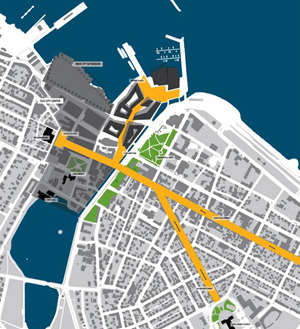 Harpa - Reykjavik Concert Hall and Conference Centre forms part of an extensive harbour development project in Reykjavik, the East Harbour Project. As the name indicates, the overall objective of the project is to expand and revitalise Reykjavik's eastern harbour with a new downtown plaza, a shopping street, a hotel, residential buildings, educational institutions and mixed industry. The overall intention is to generate life in the area and to create a better connection between the city centre and the harbour. Harpa - Reykjavik Concert Hall and Conference Centre forms part of an extensive harbour development project in Reykjavik, the East Harbour Project. As the name indicates, the overall objective of the project is to expand and revitalise Reykjavik's eastern harbour with a new downtown plaza, a shopping street, a hotel, residential buildings, educational institutions and mixed industry. The overall intention is to generate life in the area and to create a better connection between the city centre and the harbour.
 Situated outside the city's building mass, the building will become a significant icon in the city - a visual attractor with a powerful and varying expression. The isolated location will mean that, to a great extent, the changing climatic and light effects will be exposed in the facades of the concert building, often in contrast to the narrow and shady streets in the rest of the city. Situated outside the city's building mass, the building will become a significant icon in the city - a visual attractor with a powerful and varying expression. The isolated location will mean that, to a great extent, the changing climatic and light effects will be exposed in the facades of the concert building, often in contrast to the narrow and shady streets in the rest of the city. |
|
 |
 |
 |
 |
 |
 |
 |
DESCRIPTION |
 |
|
|
 |
|
 |
 |
 |
|
|
 |
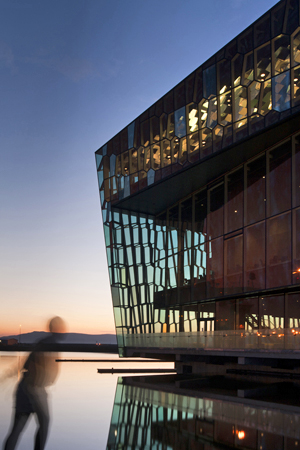 Situated on the border between land and sea, the Concert Hall stands out as a large, radiant sculpture reflecting both sky and harbour space as well as the vibrant life of the city. The spectacular facades have been designed in close collaboration between Henning Larsen Architects, the Danish-Icelandic artist Olafur Eliasson and the engineering companies Rambøll and ArtEngineering GmbH from Germany. Situated on the border between land and sea, the Concert Hall stands out as a large, radiant sculpture reflecting both sky and harbour space as well as the vibrant life of the city. The spectacular facades have been designed in close collaboration between Henning Larsen Architects, the Danish-Icelandic artist Olafur Eliasson and the engineering companies Rambøll and ArtEngineering GmbH from Germany.
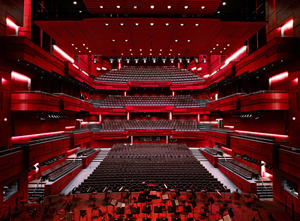 The Concert Hall of 28,000 m2 is situated in a solitary spot with a clear view of the enormous sea and the mountains surrounding Reykjavik. The building features an arrival and foyer area in the front of the building, four halls in the middle and a backstage area with offices, administration, rehearsal hall and changing room in the back of the building. The three large halls are placed next to each other with public access on the south side and backstage access from the north. The fourth floor is a multifunctional hall with room for more intimate shows and banquets. The Concert Hall of 28,000 m2 is situated in a solitary spot with a clear view of the enormous sea and the mountains surrounding Reykjavik. The building features an arrival and foyer area in the front of the building, four halls in the middle and a backstage area with offices, administration, rehearsal hall and changing room in the back of the building. The three large halls are placed next to each other with public access on the south side and backstage access from the north. The fourth floor is a multifunctional hall with room for more intimate shows and banquets.
Seen from the foyer, the halls form a mountain-like massif that similar to basalt rock on the coast forms a stark contrast to the expressive and open facade. At the core of the rock, the largest hall of the building, the main concert hall, reveals its interior as a red-hot centre of force.
The project is designed in collaboration with the local architectural company, Batteríið Architects. |
|
 |
 |
 |
|
 |
|
| Facades |
 |
|
 |
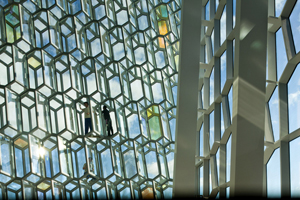 Henning Larsen Architects has designed the facade of the Concert Hall in close collaboration with the local architects Batteríið Architects and the Danish-Icelandic artist Olafur Eliasson. Henning Larsen Architects has designed the facade of the Concert Hall in close collaboration with the local architects Batteríið Architects and the Danish-Icelandic artist Olafur Eliasson.
As the rest of the building, the design of the facades is inspired by nature. In particular, the characteristic local basalt formations have provided the inspiration for the geometric facade structure.
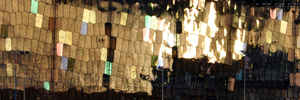 Made of glass and steel in a twelve-sided space-filling geometric modular system called the 'quasi- brick', the building appears a kaleidoscopic play of colours, reflected in the more than 1000 quasi-bricks composing the southern facade. The remaining facades and the roof are made of sectional representations of this geometric system, resulting in two-dimensional flat facades of five and six-sided structural frames. In order to develop these ideas the team worked with three-dimensional computer models, finite element modelling, various digital visualisation techniques as well as maquettes, models and mock-ups. Made of glass and steel in a twelve-sided space-filling geometric modular system called the 'quasi- brick', the building appears a kaleidoscopic play of colours, reflected in the more than 1000 quasi-bricks composing the southern facade. The remaining facades and the roof are made of sectional representations of this geometric system, resulting in two-dimensional flat facades of five and six-sided structural frames. In order to develop these ideas the team worked with three-dimensional computer models, finite element modelling, various digital visualisation techniques as well as maquettes, models and mock-ups.
Light and transparency are key elements in the building. The crystalline structure, created by the geometric figures of the facade, captures and reflects the light - promoting the dialogue between the building, city and surrounding landscape.
One of the main ideas has been to "dematerialise" the building as a static entity and let it respond to the surrounding colours - the city lights, ocean and glow of the sky. In this way, the expression of the facade changes according to the visual angle. With the continuously changing scenery, the building will appear in an endless variation of colours. |
|
 |
 |
 |
 |
 |
 |
 |
ECO-SUSTAINABILITY |
 |
|
|
 |
|
 |
 |
 |
|
|
 |
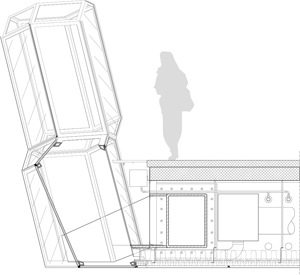 Harpa complies with the highest Icelandic thermal performance standards. Its advanced insulation and air-tight construction make it one of the greenest conference centers in the world. These elements will play a key role in minimizing energy use for heating and cooling and therefore in reducing carbon emissions. Harpa complies with the highest Icelandic thermal performance standards. Its advanced insulation and air-tight construction make it one of the greenest conference centers in the world. These elements will play a key role in minimizing energy use for heating and cooling and therefore in reducing carbon emissions. |
|
 |
 |
 |
 |
 |
 |
 |
LOCATION |
 |
|
|
 |
|
 |
 |
 |

|
 |

|
Continent |
|
 |
  Europe |
|
Nation |
|
 |
  Iceland [Ísland] |
|
Region |
|
 |
  Höfuðborgarsvæðið |
|
Town |
|
 |
  Reykjavík |
|
Address |
|
 |
  Austurbakki 2
|
|
|
|
 |
|
Telephone |
|
 |
|
Website |
|
 |
|
 |
 |
 |
 |
MAP |
 |
|
|
 |
|
 |
 |
 |
| |
 |
|
 |
 |
 |
 |
|
TYPOLOGY |
 |
|
|
 |
|
 |
 |
 |
Main |
 |
|
 |
ARCHITECTURE | Buildings for cultural activities
Congress and conference centre
Conference halls
Buildings for recreational activities
Auditoriums and music centres
Theatres
| |
|
|
 |
|
Additional |
 |
|
 |
ARCHITECTURE | Buildings for cultural activities
Art galleries and exhibition areas
Buildings for recreational activities
Cinemas
| |
 |
 |
 |
 |
CHRONOLOGY |
 |
|
|
 |
|
 |
 |
 |
Project |
 |
|
 |
| 
 |
2005
project winner of competition
|
|
Realisation |
 |
|
 |
| 
 |
2007 - 2011 |
|
 |
 |
 |
 |
AWARDS |
 |
|
|
 |
|
 |
 |
 |
| 2013 |
 |
|
 |
| European Union Prize for Contemporary Architecture – Mies van der Rohe Award |
|
 |
 |
 |
 |
 |
 |
 |
BIBILIOGRAPHIC REFERENCES |
 |
|
|
 |
|
 |
 |
 |
|
 |
| Ola Bettum, "Harpa", Arkitektur N 4/2012, pp. 42-63 |
|
|
| "Konzert- und Konferenzzentrum »Harpa« in Reykjavik / Harpa Concert Hall and Conference Centre, Reykjavik, Iceland", Detail 1/2 2012, pp. 18-22 |
|
|
| "Harpa Concert and Conference Hall, Reykjavik, Iceland / A coloured glass facade for the Reykjavik concert and conference hall distorts and amplifies light and colour", L'Arca 275, dicembre/december 2011 [Texture], pp.48-59 |
|
|
| Tom Wright, "Harpa Concert Hall. Henning Larsen Architects", Icon 101, november 2011, pp. 68-70 |
|
|
 Caia Hagel, "Harpa-Reykjavik Concert Hall and Conference Centre", Architect, october 2011, "Design" pp. 112-120 Caia Hagel, "Harpa-Reykjavik Concert Hall and Conference Centre", Architect, october 2011, "Design" pp. 112-120
"Toolbox: Quasi-Brick Façade", Architect, october 2011, "Design" p. 120 (112-120) |
|
|
| Oliver Lowenstein, "Elemental architecture", Blueprint 307, october 2011, pp. 78-84 |
|
|
| Catherine Seron-Pierre, "Opera National Reykjavik. Islande / National Opera, Reykjavik, Iceland", Moniteur Architecture AMC 209, octobre/october 2011, pp. 60-67 |
|
|
| Martin Keiding, Halli Sigurdsson, "Harpa. Reykjavik Koncertsal og Konferencecenter / Harpa. Reykjavik Concert Hall and Conference Centre", Arkitektur DK 05 2011, oktober/october 2011, pp. 2-23 |
|
|
| "Harpa Concert Hall and Conference Centre, Reykjavick. Henning Larsen Architects and Batteriid architects", a+u. Architecture and Urbanism 492, september 2011 [Art and architecture], pp. 34-43 |
|
|
| "Harpa Concert and Conference Hall, Reykjavik, Iceland", A10 new European architecture 41, september/october 2011, pp. 50-51 |
|
 |
 |
 |
 |
 |
 |
 |
CLIENT |
 |
|
|
 |
|
 |
 |
 |
| |
 |
Austurnhofn TR
East Harbour Project Ltd. |
|
 |
 |
 |
 |
AMOUNT |
 |
|
|
 |
|
 |
 |
 |
| |
 |
|
 |
 |
 |
 |
DIMENSIONAL
DATA |
 |
|
|
 |
|
 |
 |
 |
| Consistence |
 |
|
 |
1 concert hall
1 recital hall
1 auditorium
1 conference hall (dividable into 2)
8 meeting rooms |
|
| Surface |
 |
|
 |
gross floor sq.m. 28,000
Eldborg – concert hall sq.m. 1,008
Norðurljós – recital hall sq.m. 540
Silfurberg – conference hall sq.m. 735
Kaldalón – auditorium sq.m. 198
exhibition space sq.m. 2,500 |
|
| Capacity |
 |
|
 |
Eldborg – concert hall 1,800 guests
Norðurljós – recital hall 450 guests
Silfurberg – conference hall 750 guests
Kaldalón – auditorium 195 guests |
|
| Dimensions |
 |
|
 |
Eldborg – concert hall - stage m. 22 x 17
Kaldalón – auditorium - stage m. 10 x 6 |
|
| Height |
 |
|
 |
|
 |
 |
 |
 |
LANDSCAPE DESIGN |
 |
|
|
 |
|
 |
 |
 |
| |
 |
Landslag efh
Lisbeth Westergaard |
|
 |
 |
 |
 |
STAFF |
 |
|
|
 |
|
 |
 |
 |
Associate designers  |
 |
|
|
 |
|
Principal-in-charge |
 |
Peer Teglgaard Jeppesen (Henning Larsen Architects)
Sigurður Einarsson (Batteríið Architects) |
|
Project leader |
 |
| Ósbjørn Jacobsen (Henning Larsen Architects) |
|
Project management |
 |
| Klavs Holm Madsen (Henning Larsen Architects) |
|
Art intervention |
 |
|
Facades consultant |
 |
| Steen Elsted Andersen (Henning Larsen Architects) |
|
Interior design |
 |
Henning Larsen Architects
Batteríið Architects |
|
Lighting design |
 |
Henning Larsen Architects, Batteríið Architects, Zumtobel (interior lighting)
Studio Olafur Eliasson (façade lighting) |
|
Design team |
 |
Leif Andersen, Elizabeth Balsborg, Birthe Bæk, Filip Lyders Francati, Mette Kynne Frandsen, David Garcia, Niels Gravergaard, Rasmus Haak, Lars Harup, Morten Hauch, Hannibal Hink, Merete Alder Juul, Mette Landorph, Ingela Larsson, Katja Brandt Lassen, Matthias Lehr, Lisbeth Leth-Sonne, Martha Lewis, Diana Arsovic Hareskov Nielsen, Jørgen Olesen, Kristian Svejborg Olesen, Vanda Oliveira, Leonardo Paes Resende, Ina Borup Sørensen, Debbi Hedeham Thuesen, Andrea Tryggvadóttir, Helga Vilmundardóttir (Henning Larsen Architects)
Arnar Skjaldarson, Grétar Snorrason, Ingvi Þorbjörnsson, Soffía Valtýsdóttir (Batteríið Architects) |
|
Acoustical consultant |
 |
|
Engineering |
 |
ArtEngineering GmbH
Mannvit Engineers
Hnit Consulting Engineers
Efla Engineers
Rambøll |
|
Consultant |
 |
ASK Architects
Almenna Consulting Engineers
Verkis Consulting Engineers
Verkhönnun Engineers
Jasper Parrott (international consultant)
Vladimir Ashkenazy (artistic adviser) |
|
Facades |
 |
Henning Larsen Architects
Olafur Eliasson
Rambøll
ArtEngineering GmbH |
|
Construction management |
 |
|
 |
 |
 |
 |
CREDITS |
 |
|
|
 |
|
 |
 |
 |
| |
 |
Photos © Nic Lehoux, Ari Magg, Osbjÿrn Jacobsen
Drawings © Henning Larsen Architects
Text edited by Henning Larsen Architects
Courtesy by Henning Larsen Architects
|
|
 |
  |
 |
|
|